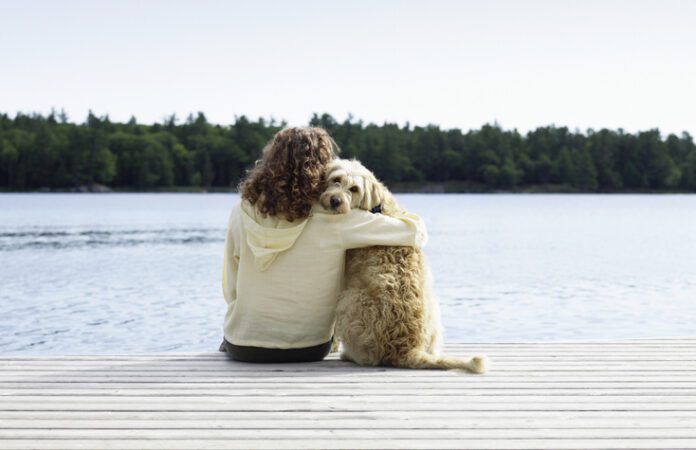
I’ve been training dogs professionally for 27 years, but I don’t use “commands” for this purpose, I use “cues.” What difference does choosing respectful dog training language make? A lot!
The definition of command is “an authoritative order.” Even when we use gentle training methods, if we think “commands,” our brains connect to the authoritative definition and we are likely speak in a louder, harsher (commanding!) tone of voice. In contrast, a cue is an invitation to perform a behavior for which your dog can be reinforced with a treat, play, praise, or the opportunity to perform a behavior the dog enjoys. We are far more likely to speak softly and gently when we use “cues.”
Words to avoid when referring to dogs and in dog training
“Command” is just one of many words that we force-free trainers avoid. Here are others that interfere with the message of kindness and mutual respect we want to send to our dogs:
- “It.” This word is used to refer to non-living objects. Dogs (and other animals) are living, thinking, feeling beings. Use he, she, him, and her rather than “it” when referring to a dog. When you acknowledge the sentience of non-human animals, you’re likely to treat them better.
- “Breaking.” Breaking evokes force, and we’re not “breaking” anything, we’re “training” – so we use housetraining (not housebreaking) and say we are training desirable behaviors (not breaking bad habits).
- “Obedience.” We want a partnership with our dogs – a happy willingness to offer behaviors we ask for, not their submission to our authority. That’s why we offer good manners training or family dog training rather than “obedience classes.”
- “Make.” We don’t “make” our dogs do things. “Make” suggests force and coercion. Instead, we ask our dogs for certain behaviors, invite them, help them, and encourage them.
- “Bad.” Dogs aren’t bad and they don’t do bad things – though occasionally they may do something inappropriate. When we think of them as bad, we give ourselves tacit permission to punish them. But when we frame their behavior as “inappropriate,” we’re more likely to think in terms of management and teaching appropriate behaviors rather than punishment.
- More pejoratives. I cringe when someone refers to a dog as stupid, stubborn, disobedient, or any other negative adjectives, placing the blame for any unwanted behavior directly on the dog’s shoulders. When a dog doesn’t do what you ask, it’s because she can’t for some reason: she doesn’t understand, she’s too stressed, was distracted, didn’t hear you, is in pain or otherwise physically unable, you haven’t made the consequence of the behavior reinforcing enough, or you haven’t generalized it well (you haven’t trained her!). Figure out why she can’t do it and then help her succeed.
Using respectful dog training language with your dog.
Think carefully about the words you and/or your instructor use to discuss training and your dog. Philosopher and cognitive scientist Daniel Dennett suggests that language lays down the tracks upon which thoughts can travel. Your words connect to your thoughts and influence your behavior. If your words align with your philosophy of creating a kind and nurturing relationship with your dog based on mutual trust and respect, you’re likely to behave accordingly – and you and your dog will be well on your way to achieving that pinnacle.






Amen, Pat;
As a vet, I hear this every day at work (he’s stubborn, he did it on purpose, etc).
Drives me crazy.
Thanks for all your great articles and for helping me with Cyf, my Am Staff, all those years ago.
Kitti
Great article, I agree 100% that how we describe something has a strong impact on how we engage with something
Well said
Thank you so much for referring dogs (as well as all non-human animals) as he/she, etc. and NOT “it”. Animals are every bit as sentient as humans. Once humans recognize and accept it – it forces us to look at our relationship with them and how we treat them. ANIMALS ARE NOT OURS TO EAT, WEAR OR EXPERIMENT ON!
Diana pawPrints weighs in at 92 pounds. She can’t help it if she is black and zaftig. Rubenesque. Big Boned. A Valkyrie. After all, she is an Amazon Princess. My Wonder Puppy.
My Dad refers to her as “The Horse.” She always gets the blame. Recently he lost one of his hearing aids and he wants me to sort through her “offerings” because he is convinced she ate it.
I refer to her as my “delicate little flower” as she is the most sensitive of the three dogs. My “free lance therapy dog.” I assured him she would have no interest in chewing on let alone swallowing his hearing aid should she stumble across it.
It is still lost. While I’m sure it will turn up, I have no interest in convincing Diana to track it down. She prefers birch, anise and clove for scentwork.
Thank goodness her command of English is very limited. It keeps her good natured and smiling.
Intonation is everything. Dogs may not understand what we’re saying but they certainly pick up on how we say it. Diana knows when I sing her name a treat is coming. They not only read our inflection but also our facial expressions.
Jack London – To Build A Fire.
Dogs are not stupid.